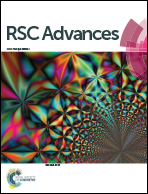A promising broadband and thin microwave absorber based on ternary FeNi@C@polyaniline nanocomposites
Abstract
Ternary FeNi@C@polyaniline (PANI) nanocomposites, in which FeNi@C nanocapsules are surrounded by PANI, are synthesized by combining the arc-discharge process and an in situ chemical oxidative polymerization reaction. The strong interactions between the carbon shell and PANI result in the blue shift of the Raman spectrum. The effect of PANI on the electromagnetic properties of the FeNi@C nanocapsules is investigated at 2–18 GHz. The bandwidth (reflection loss (RL) < −10 dB) of the FeNi@C@PANI nanocomposites keeps constant at 3.0 GHz, but the frequency range (RL < −10 dB) shifts to a lower frequency with increasing thickness from 1.7 to 3.0 mm. For a thickness of 1.4 mm, the bandwidth of the FeNi@C@PANI nanocomposites reaches a maximum value of 5 GHz (13–18 GHz). For the FeNi@C@PANI nanocomposites, a minimum RL (RLmin) of −49.2 dB is observed at 16.6 GHz for a thickness of 1.3 mm. The RLmin of the FeNi@C@PANI nanocomposites is larger than that of the FeNi@C nanocapsules and the RLmin shifts from low to high frequency under the same absorbing thickness. The FeNi@C@PANI nanocomposite can be seen as a good candidate for lightweight, thin and strongly absorptive microwave absorbents with a broad bandwidth.


 Please wait while we load your content...
Please wait while we load your content...